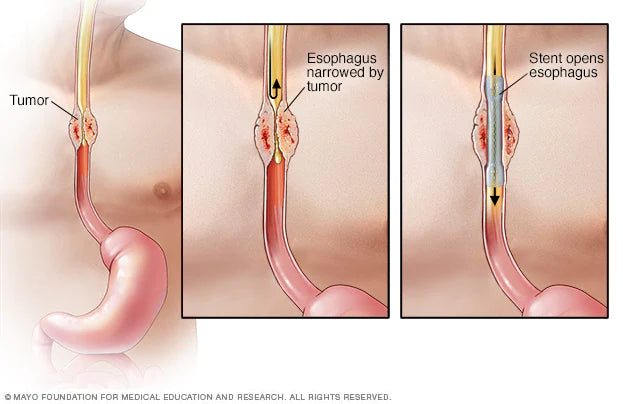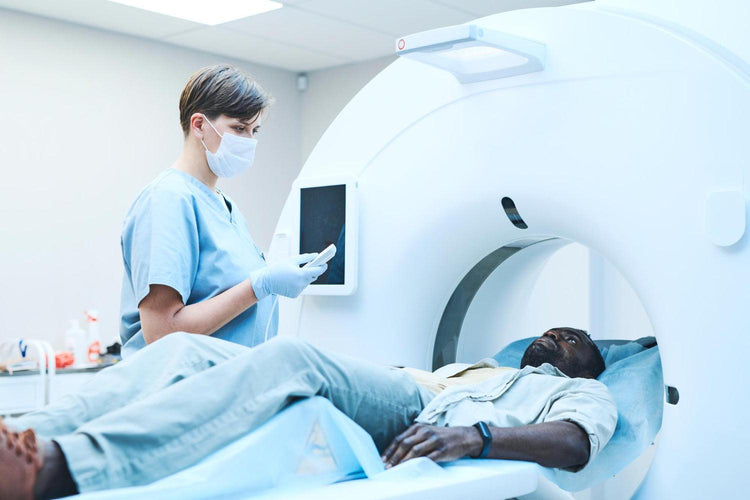
 Instagram
Instagram
Can You See Cancer in the Abdomen with Ultrasound?

Related products

Cancer refers to a variety of diseases marked by unregulated cell division and the ability of these cells to infest other tissues. This can occur through direct expansion into neighboring tissue lymph or blood. The disease usually begins in one area of the body and then disseminates elsewhere - a process known as metastasis.
It's known that there isn't just one cause for cancer. A variety of factors, such as age, genetics, and exposure to certain environmental substances (carcinogens) like tobacco smoke, contribute significantly to its development.
Embodying over 200 different types might make describing universal symptoms difficult; instead, every type comes with unique signs that depend on where it initially starts within the body. Common indicators include persistent tiredness, sudden weight loss/gain, and out-of-the-blue pain sensations without clear reasons, among many others.
Getting a precise diagnosis tends to be challenging because some forms show no specific indications until they have advanced substantially, which adds even more complexity, making detection tricky. This consequently reduces the chances of an early intervention, thus negatively impacting survival rates per se.
Traditionally, practices employed strategies including physical examinations, biopsies, and imaging tests such as CT scans, MRIs, and X-rays to identify abnormal cell behavior. Yet advanced medical science introduced innovative methods like ultrasound, PET scans, and liquid biopsy to facilitate accuracy, speed, and efficiency. Diagnostic procedures do enhance positive outcomes and interpretations.
Treatment plans rely heavily on various elements encompassing cancer's nature. Stage person and general health experts commonly utilize options for radiotherapy and chemotherapy surgery and combine them with individualized therapeutic regimens. Endorsed by the National Institute of Health in the United States, evidence indicates additional immunotherapy gene-targeted drugs have been increasingly adopted globally to achieve better quality of life and prolonged patient expectancy in recent years. Evidence-based medicine is the key driving force behind the evolving landscape, offering hope to those affected by the dreaded disease and developing novel ways to beat the mortality rate associated with several types.
When answering ultrasound questions, imagine the presence of abdominal views among clinicians, which seem divergent. As Dr. Richard Barr, MD PhD Professor of Radiology North-East Ohio Colleges noted, technological advancements efficiently detected many forms of soft tissue organs like the liver, pancreas, and kidney ovaries. However, it is not necessarily effective for all types due to its limitations, such as difficulties seeing through the air (found in the stomach and intestines) and bones. Moreover, the ability to differentiate between benign and malignant tumors is limited; hence, he added that it plays a crucial role in the diagnostic arsenal, often used with other tools and comprehensive analysis.
Postulating facts gathered by the American Society of Clinical Oncology 2020 indicated about 1.8 million new cases diagnosed in the US alone, with the death toll reaching approximately 606,520. Both figures serve as sober reminders that it is imperative to implement advanced earlier detection methods to lower dire statistics in the future.
Cancer In The Abdomen And Its Symptoms?

Cancer is a broad term denoting diseases characterized by abnormal cells growing uncontrollably and invading healthy tissues. It begins at the genetic level, with DNA alterations resulting in mutations responsible for unregulated cell growth.
Abdominal cancer, also known as cancer in the abdomen, is a general term that covers multiple types of malignancies occurring within several organs found in the abdominal region. These include cancers such as liver, gastric (stomach), pancreatic, ovarian, and colorectal. Each type of abdominal cancer bears distinct symptoms rooted in developments occurring inside specific organs affected due to its progress stage.
A general symptom often associated with most cases is persistent discomfort or pain felt anywhere within one's belly area. It might feel vague initially but progressively worsens over time, becoming more localized.
Unexplained weight loss serves as another common sign of these conditions; despite similar diet exercise routines, still losing considerable amounts could point towards underlying medical issues potentially related to malignant growths.
Digestive problems are usually indicative of some forms, specifically gastric colon, wherein individuals experience consistent changes in bowel habits such as frequent constipation, diarrhea, Nausea, indigestion, and vomiting without reasonable cause become notable too, mostly linked to insurgence esophageal pancreas gallbladder tumors.
Peptic issues like heartburn, acidity, bloating, passing gas excessively, and finding it difficult to swallow are typically cases of upper digestive tract malignancies. The lower rectum involves the presence of blood stool, unusually thin stools, and a constant urge to have bowel movements even after having one.
Furthermore, women dealing with ovarian may encounter additional signs ranging as ongoing pelvic backache, swollen appearance, increased waist size, trouble eating, feeling full quickly, and unpredictable menstrual bleeding. In very late stages, there may be shortness of breath, tiredness, lack of energy, jaundice, and yellowing skin and eyes. If the liver is involved, ascites, fluid buildup around the lungs. Usually, they show up with subtle, hard notice; hence, crucial conduct screenings, particularly post-menopausal, when they are at high risk of developing particular diseases.
Understanding body transformations and seeking prompt expert advice on any unusual persistent key to detecting and successfully treating the mentioned. Hence, annual physical exams, knowledge about family history, and regular discussions with healthcare providers regarding potential risks form essential parts of a proactive approach against the onset progression of devastating diseases.
Diagnosis of Cancer in The Abdomen
Diagnosis of cancer in the abdomen involves a thorough examination process to accurately identify the condition and determine its extent. The procedures incorporated are as follows:
- Medical History: Gathering a comprehensive medical history remains crucial at the onset. Past illnesses, surgeries, lifestyle habits, and family health background constitute key data facilitating preliminary understanding.
- Physical Examination: Doctors conduct an abdominal exam, feeling for any lumps or areas causing discomfort while checking the patient's general physical condition, considering factors like weight loss, skin color, and continued fatigue, among others.
- Imaging Tests: Technologies such as ultrasound, computed tomography (CT) scans, magnetic resonance imaging (MRI), and positron emission tomography (PET) generate detailed imagery inside the belly to highlight abnormalities indicative of malignancies.
- Biopsy: A tissue sample collected from a suspected region is examined closely under a microscope, and malignant cells are definitively absent. This confirms the diagnosis and helps identify specific types, providing vital clues towards designing effective treatment plans.
- Blood Tests: Certain secret substances termed tumor markers are detected in the bloodstream using specialized tests. CA 125, for example, commonly monitors ovarian, pancreatic, and liver cancers. Another instance is carcinoembryonic antigen CEA, which helps diagnose colorectal cases. However, it is usually conclusive; hence, the diagnostic methods deliver accurate results.
- Laparoscopy: involves inserting a thin tube-equipped light camera through a small incision near the navel, allowing direct inspection of abnormal growths and even permitting the collection of samples. Additional pathology study is performed when needed, validating findings obtained from other tools and techniques.
- Genomic Testing/Molecular Profiling: This cutting-edge technique reveals genetic makeup, particularly allowing doctors to understand detailed characteristics of behavior. It enables personalized therapeutic approaches based on an individual's unique molecular profile.
Early detection is paramount to successful management. Therefore, regular screening is advised, especially for at-risk patients due to age and environmental exposure. Implementing suitable diagnostics promptly facilitates better prognosis by alleviating symptoms and improving survival odds.
Can You See Cancer in the Abdomen with Ultrasound?

Yes, an ultrasound can effectively visualize cancer in the abdomen. Utilizing high-frequency sound waves, ultrasounds create images of various structures within the body. This non-invasive diagnostic technique provides real-time dynamic imaging, which allows for immediate assessments of abdominal organs like the liver, gallbladder, spleen, kidney, and pancreas, among others. It aids in identifying irregularities, such as lumps or masses, that might signify a malignant growth. Nonetheless, while it's been effective at detecting soft-tissue cancers, its effectiveness is restricted based on the location and characteristics of certain tumors.
Its limitation springs from the fact that it struggles to see through air-filled areas (typically found in the stomach and intestines) bones, which proves challenging when dealing with gastrointestinal bone malignancies. Moreover, differentiating benign tumors from their malignant counterparts based solely on imagery is difficult; hence, it is often used with complementary diagnostics methods, such as CT scans and MRI, offering more detailed insight into possible underlying pathology and aiding confident diagnosis.
A case report published on Carcinoma of stomach detected by routine transabdominal ultrasound in NIH recommend that attention be paid to gastric wall pathology during routine scanning for patients with relevant symptoms.
Despite shortcomings, essential component arsenal sound waves show potential harm to tissues, making safe repeated use following treatment progress monitoring condition over time. These advantages continue to serve a pivotal role in screening preliminary assessment guides where biopsy is needed and even assist during surgical procedures, sometimes ensuring comprehensive, accurate analysis eventually, effective management strategy.
Summary
Cancer, characterized by abnormal cell growth and tissue invasion, manifests with varying symptoms. Its detection involves physical examinations, biopsies, and imaging tests, such as an ultrasound. Despite its usefulness in visualizing soft-tissue cancers, ultrasounds' effectiveness can be limited depending on the tumor's location and nature. Abdominal cancer includes several malignancies within belly organs with symptoms including persistent discomfort or digestive issues. Regular check-ups and understanding family history are crucial for early diagnosis, leading to more favorable outcomes.
Frequently Asked Questions
What cancers can an abdominal ultrasound detect?
An abdominal ultrasound is useful in detecting cancers within soft tissue organs such as the liver, pancreas, kidneys, and ovaries.
What cancers cannot be detected in ultrasound?
Ultrasounds encounter difficulty in identifying tumors located in air-filled regions like the stomach or intestines, as well as bone-related malignancies.
What can an ultrasound detect in the abdomen?
In addition to tumors, ultrasounds have been effective at finding conditions such as gallstones, kidney stones, and even aortic aneurysms.
What does cancer look like on an ultrasound scan?
On a sonogram or ultrasound image, malignant growth typically manifests itself visually by differing from surrounding healthy tissues—appearing irregular or lumpy.
How accurate is an abdominal ultrasound?
While effectiveness varies depending upon factors related to the type of condition being screened (like location and characteristics), it isn't consistently decisive across all clinical scenarios, so overall accuracy would differ accordingly.
What can ultrasound not detect?
Ultrasound struggles to conclusively identify benign versus malignant growths of certain small tumors deep inside body microcalcifications common breast cancer due to limited resolution capabilities specificity.


















 Rated Excellent by 26,523+ Reviews
Rated Excellent by 26,523+ Reviews